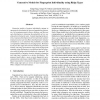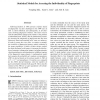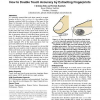11 search results - page 2 / 3 » A Minutiae-based Fingerprint Individuality Model |
ICB
2009
Springer
13 years 12 months ago
2009
Springer
Abstract. Fingerprints are considered to be unique because they contain various distinctive features, including minutiae, ridges, pores, etc. Some attempts have been made to model ...
IEEEIAS
2007
IEEE
13 years 11 months ago
2007
IEEE
Generative models of pattern individuality attempt to represent the distribution of observed quantitative features, e.g., by learning parameters from a database, and then use such...
AUTOID
2005
IEEE
13 years 11 months ago
2005
IEEE
Following Daubert in 1993, forensic evidence based on fingerprints was first challenged in the 1999 case of USA vs. Byron Mitchell, and subsequently, in 20 other cases involving...
ICCS
2007
Springer
13 years 11 months ago
2007
Springer
Abstract. Frames, i.e., recursive attribute-value structures, are a general format for the decomposition of lexical concepts. Attributes assign unique values to objects and thus de...
CHI
2010
ACM
14 years 6 days ago
2010
ACM
It is generally assumed that touch input cannot be accurate because of the fat finger problem, i.e., the softness of the fingertip combined with the occlusion of the target by the...



